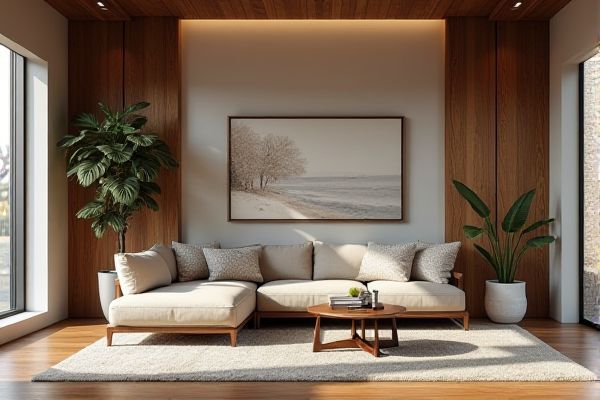
Distressed wood offers a rustic, vintage charm with its weathered texture and imperfections, while polished wood provides a sleek, smooth, and shiny finish that enhances elegance and modernity. Discover which wood style best suits Your space by exploring the detailed comparisons in the rest of the article.
Table of Comparison
| Feature | Distressed Wood | Polished Wood |
|---|---|---|
| Appearance | Worn, rustic, aged look with intentional imperfections | Smooth, shiny, and refined surface with a glossy finish |
| Texture | Rough texture with visible grain and marks | Even, sleek texture with minimal grain visibility |
| Durability | Durable but prone to wear due to surface treatment | Highly durable with protective coating against damage |
| Maintenance | Low maintenance; scratches and marks enhance aesthetic | Requires regular cleaning and polishing to maintain shine |
| Style | Rustic, vintage, shabby chic, farmhouse | Modern, classic, elegant, formal |
| Cost | Generally affordable due to minimal finishing process | Often higher cost due to labor-intensive finishing |
| Common Uses | Furniture, flooring, decorative accents in casual spaces | High-end furniture, cabinetry, flooring in formal settings |
Introduction to Distressed Wood and Polished Wood
Distressed wood features a weathered, aged appearance achieved through techniques like sanding, denting, and staining, creating a rustic and vintage aesthetic. Polished wood is smooth, glossy, and refined, enhanced by buffing and sealing to highlight the natural grain and provide a sleek finish. Your choice between distressed wood and polished wood impacts the overall ambiance, blending either casual charm or sophisticated elegance into your space.
Key Characteristics of Distressed Wood
Distressed wood features intentional imperfections such as dents, scratches, and weathered finishes that create a rustic, aged appearance distinct from the smooth, reflective surface of polished wood. Its texture often showcases natural grain patterns enhanced by techniques like sanding, staining, or whitewashing, contributing to a vintage or farmhouse aesthetic. This type of wood is prized for its character and unique, handcrafted look, contrasting with the uniformity and sleekness of polished wood.
Key Characteristics of Polished Wood
Polished wood features a smooth, glossy surface achieved through sanding and applying finishes like varnish or lacquer, enhancing its natural grain and color. This finish provides durability, resistance to moisture, and makes cleaning easier, ideal for high-traffic areas or elegant furniture. Your choice of polished wood adds a refined and sophisticated look, contrasting with the rustic and textured appeal of distressed wood.
Visual Appeal: Rustic vs. Refined
Distressed wood offers a rustic visual appeal characterized by weathered textures, knots, and imperfections that evoke a sense of history and natural charm. Polished wood presents a refined, smooth surface with a glossy finish, highlighting the grain patterns while providing a sleek and modern aesthetic. Choosing between the two depends on whether your design goal emphasizes authentic, rugged character or clean, sophisticated elegance.
Durability and Maintenance Comparison
Distressed wood offers enhanced durability due to its intentionally rugged surface, which effectively hides scratches and dents, making it ideal for high-traffic areas or homes with pets and children. Polished wood, while visually appealing with its smooth and glossy finish, requires regular maintenance such as polishing and careful cleaning to prevent scratches and water damage. Your choice between the two should consider the balance between low-maintenance durability and a refined appearance.
Applications in Interior Design
Distressed wood adds a rustic, vintage charm to interior design, commonly used in farmhouse-style furniture, accent walls, and reclaimed wood flooring to create a warm, textured ambiance. Polished wood delivers a sleek, refined look ideal for modern interiors, featuring prominently in cabinetry, flooring, and high-end furniture that demand smooth finishes and a glossy aesthetic. Your choice between distressed and polished wood will significantly influence the room's mood, with distressed wood offering character and history, while polished wood emphasizes elegance and sophistication.
Cost Differences: Budget Considerations
Distressed wood generally costs less than polished wood due to lower manufacturing and finishing expenses, making it a budget-friendly option for adding rustic charm to your space. Polished wood involves more labor-intensive processes, such as sanding and applying multiple layers of finish, which increases its overall price. Choosing distressed wood can help you achieve a stylish look while staying within your budget constraints.
Environmental Impact and Sourcing
Distressed wood often comes from reclaimed or salvaged sources, reducing deforestation and lowering environmental impact by reusing existing materials. Polished wood typically involves freshly cut timber, which may contribute to habitat loss and increased carbon emissions due to logging and processing. Your choice of distressed wood supports sustainable sourcing practices, promoting eco-friendly construction and design.
Trends in Furniture and Flooring
Distressed wood furniture and flooring have gained popularity for their rustic, vintage aesthetic, appealing to consumers seeking character and a worn-in charm that complements farmhouse and industrial styles. Polished wood surfaces remain a staple in modern and contemporary designs, prized for their sleek, smooth finish and ability to showcase wood grain with a high-gloss or satin sheen. The trend shift toward sustainability and authenticity drives increased demand for distressed wood, while polished wood continues to be favored for formal and minimalist interiors.
Choosing the Right Wood Finish for Your Space
Distressed wood offers a rustic, vintage charm with its weathered, textured appearance, ideal for creating a cozy, lived-in atmosphere, while polished wood provides a sleek, smooth surface that enhances brightness and sophistication in modern or formal settings. When choosing the right wood finish for your space, consider the room's overall aesthetic, the level of maintenance you can commit to, and the durability required to match your lifestyle. Your choice between distressed and polished wood directly affects ambiance, upkeep, and how the wood interacts with natural or artificial lighting.
 homyna.com
homyna.com